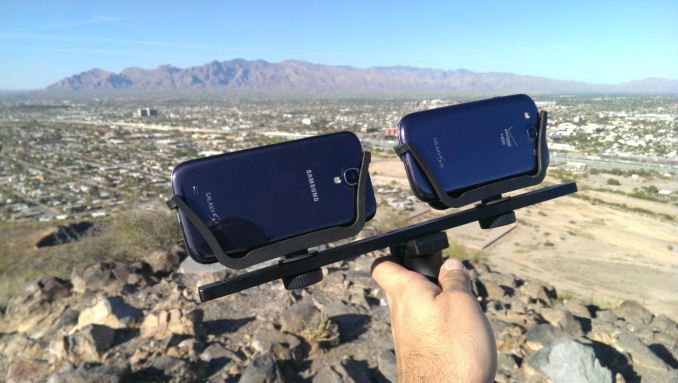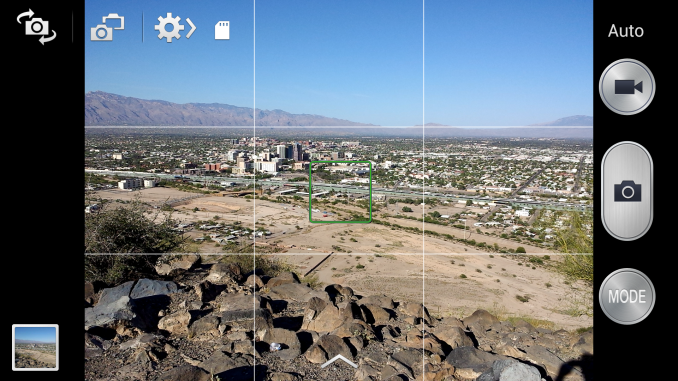Samsung Galaxy S 4 Review - Part 1
by Brian Klug on April 24, 2013 12:01 AM ESTCamera on SGS4
On the camera side Samsung is in an interesting position. The industry trend is overwhelmingly to go to more pixels and push the megapixel count up from 8 MP where most flagships sat last year to around 13 where they will sit this year. Samsung has to push that number to keep itself in a defensible and marketable position and at the same time deliver a camera experience that’s better than the previous year.
I published a table in the One review with the camera specifications from the previous generation. I’ve filled this in with confirmed information from the SGS4 review unit I have been taking samples with. With SGS4 Samsung does make some pretty considerable improvements, many of which undo some of the regressions that I described with SGS3. Focal length is now quite a bit longer, from the very wide SGS3 which was around 26mm in 35mm effective numbers, to 31 mm. This is a notable difference if you’re shooting with the two side by side, the SGS3 was always shockingly wide for a rear facing camera.
| Smartphone Camera Comparison - 2013 | |||||||
| HTC One | Samsung Galaxy S 2 | Samsung Galaxy S 3 | Samsung Galaxy S 4 | ||||
| Front Camera | 2.1MP | 2MP | 1.9MP | 2MP | |||
| Front Camera - CMOS |
OV2722 (1.4µm, 1/5.8") |
- |
S5K6A3 (1.75µm, 1/6") |
S5K6B2 (1.34µm, 1/6") |
|||
| Front Camera - Focal Length | ~1.59mm | 2.73mm | 2.7mm | 1.85mm | |||
| Front Camera - Max Aperture | F/2.0 | F/2.8 | F/2.8 | F/2.4 | |||
| Rear Camera | 4MP | 8MP | 8MP | 13MP | |||
| Rear Camera - CMOS |
ST VD6869 (2.0 µm, 1/3") |
S5K3H2YX (1.4µm 1/3.2") |
Sony/Samsung (1.4µm, ~1/3") |
IMX091PQ (1.12µm, 1/3.06") |
|||
| Rear Camera - Focal Length |
3.82mm (28mm eff) |
3.97mm (30mm eff) |
3.7mm (~26 mm eff) |
4.2mm (31 mm eff) |
|||
| Rear Camera - Max Aperture | F/2.0 | F/2.65 | F/2.6 | F/2.2 | |||
At the same time, F-number has improved dramatically, from the F/2.6 or 2.65 (I’ve seen both at times) aperture on the SGS3 to a much faster F/2.2. This dramatically improves the light collection abilities of the camera, by essentially a half stop. It’s difficult optical design to both keep the module thin enough to fit in the device without creating a huge bump (there’s a camera bump on SGS4, it’s there), increase focal length, improve F/#, and improve MTF for a better sensor all at the same time.
On the rear facing camera we see a Sony CMOS who continues to dominate the space, this time with an IMX091PQ sensor. On the front we Samsung’s own sensor, the S5K6B2 get used. Samsung also continues to go with a dedicated Fujitsu ISP inside the SGS4, this time it’s a new M10MO family which there isn’t a whole lot of information about. I suspect this continues to be done to mitigate the differences in SoC ISP between the APQ8064ab variant and Exynos 5 version and make tuning easier on Samsung’s camera team.
Imaging is increasingly a key differentiator for smartphones since it’s that device you always have on your person to take images with. For SGS4 camera is more of an emphasis this time around than it was with SGS3, which largely kept everything the same and just added software features. SGS4 brings better hardware and additional software features to do something with the hardware.
Outdoors in bright light the increased spatial resolution afforded from going from 8 MP to 13 MP helps. Samsung still does a lot of sharpening and there are halos around a ton of different features if you know where to look, but that’s the tuning they have opted for. I suspect we still are outresolving the sensor here, but I’m impressed with what I see with enough light. I took a lot of photos side by side with SGS3 and find SGS4 a notable improvement, but I’m not sure whether that’s just more damning commentary on SGS3 than anything else. I haven’t had time to put together many side by sides with buttons yet. I’ve been shooting with the HTC One on −2 sharpness since I prefer it that way, note that I accidentally left it this way with when making comparisons here since that’s still my daily driver until I can get an AT&T or T-Mobile SGS4 to use.
In lower light unsurprisingly we see the SGS4 offer better results than the SGS3 but still not quite as good as the HTC One. Samsung recently introduced low light shot on the SGS3 and Note 2, this feature carries over to the SGS4 but gets renamed back to Night Mode, even though behavior appears superficially to be the same. The SGS4 also introduces an auto night mode toggle, although this ships by default turned off. The mode automatically switches on night mode when it senses that you’re going to underexpose using the auto presets, I would advise basically leaving this on all the time. Unfortunately night mode introduces huge shot to shot latency that seems to be on the order of seconds — tap the button, capture runs, then there’s a progress bar that pops up while multiple exposures are ostensibly recombined into one image. You also have to be exceptionally steady to get an image without blur since it appears that this mode takes multiple images to get to the end goal — a better exposed image without tons of noise.
In the end there’s really no free lunch for anyone — you can temporally oversample (Samsung low light shot, or longer exposures with OIS like Nokia), or increase the size of your sampling area (larger pixels a-la HTC One), or do nothing and just give up unless you’re in a bright outdoor setting.
Samsung has introduced a bunch of new photo modes in the software on the SGS4, a number of which are actually pretty functional and awesome. There's the ability to create animated gifs from right in the camera, for example, where users paint a mask around the region they want animated from a short capture. This is essentially the same as Nokia's cinemagraph Lens from the Lumia 920, but it's still quite cool.
There's also dual camera, which lets you include a small overlay of the front facing camera atop the rear facing camera image. It initially struck me as a bit gimmicky but actually can be hilariously fun to share your face atop images to friends. It is also quite possibly the stuff of nightmares.
Panoramas on the SGS4 also are nicely put together and integrate continuously rather than get combined from a number of discrete images. The result is quite nice.
The user interface on SGS4 is a departure from the interface which has been present on previous Galaxy smartphones, and instead takes much UI/UX from the Galaxy Camera. Gone are the customizable toggles on the left side, instead options are in an expandable menu at the very top, and then another separate window. I got used to it pretty quickly but do miss the ability to customize the quick settings buttons on the left side and used to think that Samsung had the most powerful camera interface around. Things are moved around generally in a logical fashion however and I can understand how much this works to make transitioning between Galaxy Camera and SGS4 easy.
Video
When it comes to video, the SGS4 is records 1080p30 video at 17 Mbps H.264 High Profile.
I've done the usual thing and uploaded a sample to YouTube as well as our own servers for your inspection.
Video quality looks really nice and sharp on SGS4 from what I can tell by default. Anti shake (EIS in this case) is disabled out of the box, enabling it pops up a box warning you that stills captured during video record will be a different field of view.






























335 Comments
View All Comments
redchar - Wednesday, April 24, 2013 - link
I'm shocked to hear on a tech site that there's a person who would prefer the HTC One. And why not plastic? It's no mystery why plastic is a popular material. It's lightweight, cost efficient, and comes in a variety of styles and textures to allow creativity and good looks (granted, samsung's plastic is rather bland compared to the type you'd find on older HTC phones). Beyond that, plastic even has/plasticity/
That's right. A type of material that withstands drops instead of denting, being put on mobile devices such as laptops and phones. Crazy, right? I wish HTC would go back to plastic, among other bad changes they've made.
And to top it off, the HTC One, like many "high end" HTC phones as of late, does not include a memory slot or a removable battery. With such useful, and easy-to-implement features, it's a wonder that anyone would consider it a high end phone. And no surprise that galaxy phones all sell very well during a time where the industry is leaving out major functionality and at the same time struggling to sell as many units as they'd like (I wonder why?).
While the SGS4 is by no means a perfect device (it's too large, and with a pointlessly high resolution screen that might impact performance in some way [perhaps battery life as a result of trying to maintain good screen brightness, or stressing the GPU more]), it does contain a list of features that you'd expect for a phone of its price. The only thing the HTC One has over it is the sort of camera people wanted all along: quality, not megapixels.
MilwaukeeMike - Wednesday, April 24, 2013 - link
While I understand you're point, there are a lot of people who disagree with you. The iPhone has no SD card, no removable battery and is made out of metal and it's sold quite well. I've always ripped them for leaving out a card slot and charging $100 for an extra 16GB. But HTC gives you 32GB in it's base model and charges more for an extra 32, not 16. They also have USB on-the-go, which allows your phone to host a USB drive with a $3 adapter. Sure, that's a workaround, but it's enough for me. No removable battery is a bit of a bummer, but my battery is still going strong 30 months later in my current phone, so I'm not worried about it getting old and dying. I also have chargers everywhere because micro USB is so common, so I'm not worried about getting stranded either.Thegonagle - Wednesday, April 24, 2013 - link
Plastic is lower cost than metal for Samsung, but not necessarily for me. As a consumer, Samsung's cost is irrelevant. Please don't mention the cost merits of plastic until the S4 is less expensive than the HTC One.crypticsaga - Wednesday, April 24, 2013 - link
^This. I don't understand why with the iphone5 and HTC one available anyone would buy a Samsung S. You get less for more money. If you make the argument about battery and SD card then I would expect that you use more than 32GB of space and carry around a spare battery in your pocket. The funny thing is I have yet to meet a samsung owner who actually does.danbob999 - Wednesday, April 24, 2013 - link
You get a faster SoC, more sensors, a larger display, a smaller and lighter device, a larger battery and more supported LTE bands.Not everyone cares about the look of a phone.
sigmatau - Thursday, April 25, 2013 - link
You also get a worse screen and speaker than the HTC One.mrochester - Friday, April 26, 2013 - link
Those features are of questionable day to day value, however. I gain far more from having a device that looks great every time I use it in comparison to features I might use once in a blue moon, but the device is sinfully ugly.tipoo - Sunday, April 28, 2013 - link
The SoC is basically a wash between the One and the S4, it's the same SoC just with the slightest amount more speed in one.dyc4ha - Wednesday, April 24, 2013 - link
That is like saying I bought a Ferrari with cheap plastic seats while the same-priced Lambo came with leather seats and it doesnt matter to you. Wha?blue_urban_sky - Friday, April 26, 2013 - link
Yes that is exactly what its like saying. because everyone has the same priorities as you and will buy a super car based on seat material.